2024 Kia Carnival review: Manners make the van
Small improvements in all areas, but the price hike feels excessive.
Published on Oct 22, 2024 11:00:00 AM
20,259 Views
Follow us on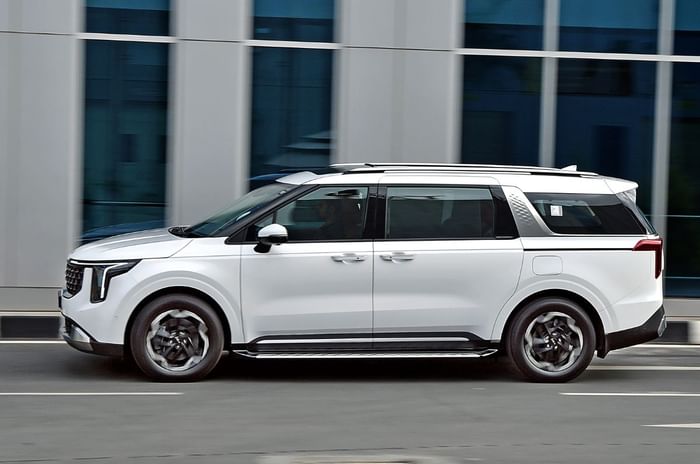
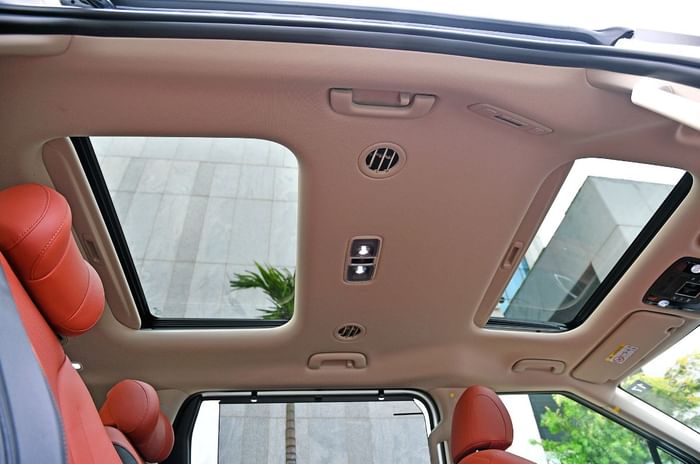
There are two seperate sunroofs for the first and second rows.

Even the third row gets its own window blinds.
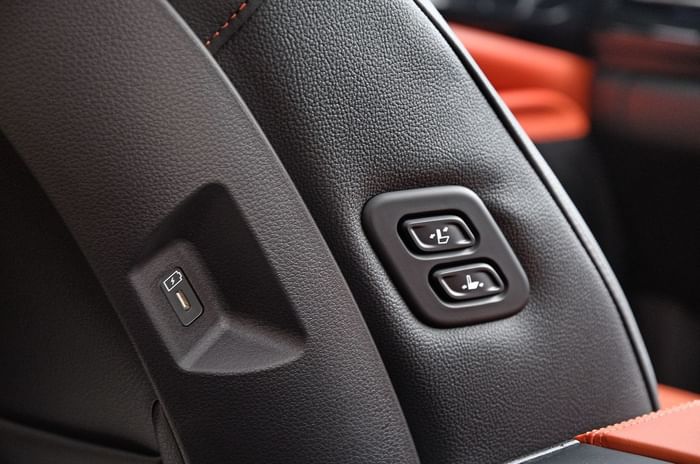
'Boss mode' moves the front passenger seat forward to liberate more second row space
We Like
- Spacious, flexible interior
- Second-row comfort
We Don't Like
- Price
- Engine noise
To say the Kia Carnival was a high-risk, high-reward product would be an understatement as big as the MPV itself. At the time of its launch in February 2020, the brand had only been in India for six months, and though its first product, the Seltos, was a runaway success, Kia was yet to become a household name.
To then launch a premium diesel MPV positioned above the near-untouchable Toyota Innova Crysta, and that too with an investment in local assembly? It sounded crazy. Sure, it sold nowhere near as many units as the rest of Kia’s products (or the Innova), averaging about 3,600 units a year, but it carved a niche for itself deep enough to warrant a sequel.
Perhaps not many knew that the 2020 Carnival for India was really a 2014 model globally (Gen 3: YP) that was at the end of its life; in fact, the next model (Gen 4: KA4) was simultaneously going on sale in other markets. But, the YP lived on in India until April 2023, when it succumbed to the BS6 Phase II emissions norms.
| Kia Carnival Price, Mileage, Specifications, Features and Variants | |
|---|---|
| Brand | Kia |
| Model Name | Carnival |
| Kia Carnival Price | ₹ 75.55 lakh |
| Kia Carnival Range/Mileage | Diesel : 14.85kpl |
| Kia Carnival Specifications | MUV | 5 doors | 7 seats View All Specs |
| Kia Carnival Features | LED headlight | 12.3-inch Touchscreen display | 8 airbags View All Features |
| Kia Carnival Variants | Limousine Plus 2.2 Diesel AT View All Variants |

However, rather than just launching the KA4 (it was shown at the 2023 Auto Expo) immediately, Kia opted to wait until it got a facelift so India would get the latest model possible and not lag the rest of the world like last time, and that’s the car you see here.
2024 Kia Carnival colours, dimensions, exterior design
History lesson over, let’s talk about the new Carnival, whose basic premise hasn’t changed much. It’s still a massive vehicle, at 5,155mm long, 1,995mm wide and 1,775mm tall, with an E-class-like 3,090mm wheelbase, which are gains of just 40mm, 10mm, 20mm and 30mm, respectively, over the previous car.
It carves a silhouette similar to the previous car, even using the exact size of wheels - 18 inches, with a set of chunky tyres. Look closely, and you’ll notice the bonnet is longer, taller and more horizontal, while the front overhang is 20mm shorter and the rear overhang 30mm longer, all of which give it slightly more SUV-like proportions.

Since this design is a facelift of a generation jump, the details are far removed from the previous car and in line with the newest Kias. The ‘Tiger Nose’ grille is wide, and hovering above it are LED strips that join the tall, slim headlamps pushed out to the very sides of the nose. Lighting is via prominent ‘ice cube’ LED projector elements stacked vertically, and even the fog lamps at the base of the bumper look similar. Spot the radar element in the centre of the air dam.
To break the monotony of the slabby sides is a vertical dappled brushed silver trim piece, as well as a black element between the doors. Sadly, the exposed rail over the rear wheel arch for the sliding rear door returns and is an eyesore, as is the huge gap under the floor (for the same purpose), which you’ll see when you open the door.
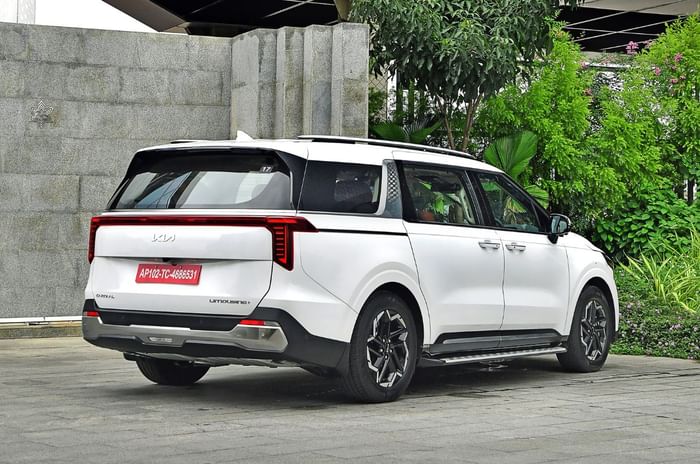
The rear, similar to the front, adopts slim vertical LEDs joined by a thin horizontal strip, highlighting the added width, while a brushed metal trim element in the bumper adds some character. The rear wiper, meanwhile, is hidden under the spoiler when not in use.
Incidentally, the powered tailgate opening is wider than before, giving even better access to the mammoth 627-litre boot – that’s with all the seats in place, by the way, thanks to a deep underfloor storage as before, and Kia says it will hold four large suitcases. Fold everything down, and you’re looking at 2,900 litres of space.

The 2024 Kia Carnival is available in just two colours - Fusion Black and Glacier White Pearl - as that, the brand says, made up the bulk of the previous car’s sales. A small hint at the target demographic, if you will.
2024 Kia Carnival interior space and comfort
Where the previous model offered 7-, 8-, or 9-seat configurations, the new Kia Carnival only comes in top-spec Limousine+ spec, with seven seats in a 2-2-3 layout. This was by far the most popular layout in the previous model, owing to buyers primarily purchasing it for second-row use.
The pair of vast captain’s chairs slide back and forth manually, requiring some muscle to move their bulk; that’s easier done once seated. They also slide left to right, but this is actually a functional requirement rather than a cool gimmick, as it might seem. With seats in their outermost position, you have ‘access mode’, placing them closer to the doors but also creating a gap between them to access the third row – the only access available. However, in this mode, their fore-and-aft movement is limited, so to access their full potential, they have to be pushed inward to the centre.
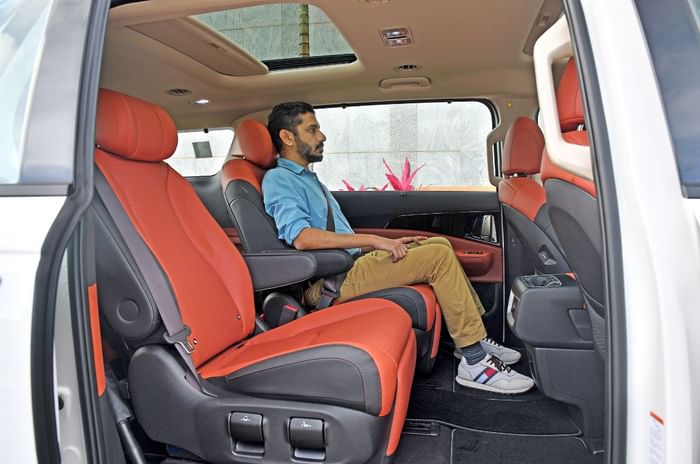
With this done, you can slide it a few inches further back and a few more still if you fold the third row away. And having them in the centre means they don’t foul with the third-row armrests, so you can fully recline the backrest and extend the ottoman with sufficient space to stretch out. For still more space, there’s a ‘boss mode’ to move the front passenger seat forward.
There’s even some height adjustment on the second row, and you can vary the seat base angle to an almost comical level. These functions, along with the recline and ottoman, are now powered, but the controls are oddly located on the inner side of the squabs, making them difficult to reach when the seats are pushed together.

In terms of creature comforts, the second row once again gets its own separate sunroof; the seats are heated and ventilated; there are manual window shades; and there’s a pair of USB-C chargers, unusually located in the seat backs of the first row. The cup holders, too, are between the front seats, so if you have the second row slid back, you won’t be able to reach them.
There is a third climate zone for the second and third rows, but the AC controls are once again oddly located on the right side of the roof, above the driver’s seat, and you only get four small roof-mounted AC vents. That said, cooling didn’t seem to be a problem during our drive.
The third row is a three-seat bench, which feels tight for three adults but just right for two, though the placement of the seat belts might restrict you. The headroom is decent; you can recline the backrest, and with the sheer range of fore and aft sliding for the second row, legroom can be either too little or a whole lot. So, as long as the middle seats are kept upright, there can be sufficient space for all.
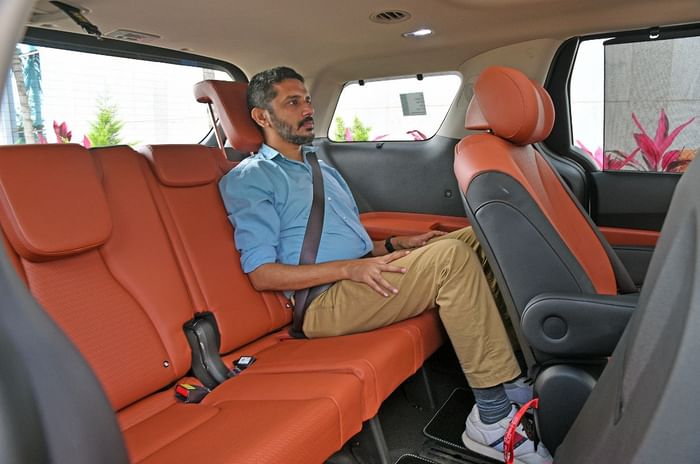
The front seats are big and comfortable, though a little firm in the upper back area. They’re ventilated and heated, with 12-way power adjustment and memory function for the driver.
2024 Kia Carnival features and safety
Much like with the exterior, the cabin design and layout feel like the biggest leap forward for the Carnival. While the previous one was well-built, decently kitted out and practical, its look was decidedly last-generation. This one elevates things in every area, with the same futuristic design as all modern Kias.
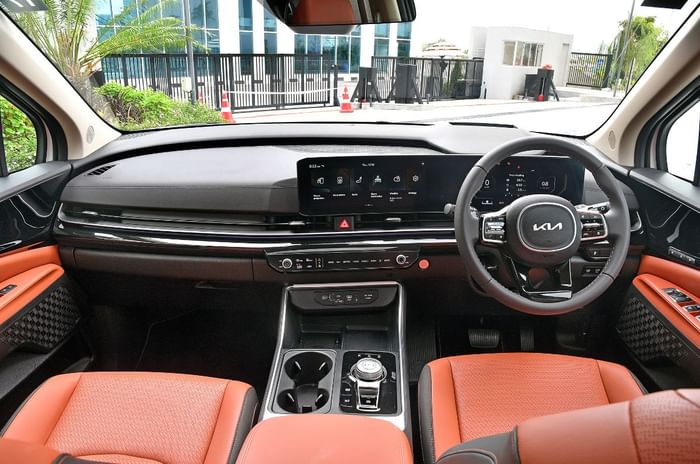
There’s a clean and horizontal layout to the dash, accentuated by the strip of ambient lighting on the passenger side and the slim AC vents in the centre. Below these, you’ll find a context-sensitive touch panel that switches between HVAC and audio controls, which looks cool but is frustrating to use in a hurry.
Further down is a wide central console that really highlights the space between driver and passenger, and it’s put to good use with a big storage bin, wireless charging tray, USB-C ports and large cup holders. The gear lever has made way for a crystalline rotary selector that looks and feels upmarket.

In fact, that sensation is only enhanced by excellent material quality all around and generous use of soft-touch materials, typical of a modern Kia. A particularly high-quality touch is the row of metallic toggle switches for seat heating and ventilation and a few other functions.
The twin 12.3-inch curved screen array feels bang up to date with its free-standing and hood-free design, and the graphics especially make it look techy and state-of-the-art. Touch sensitivity and smoothness aren’t up there with the best in the industry and are about the same as you’ll find in a Seltos; some might expect more at this price.

The 12-speaker Bose audio system fills up the large cabin nicely, while other feature highlights include ADAS with Level 2 autonomous capability, eight airbags, a heads-up display, and powered, sliding rear doors that can be operated from the handle, the driver’s seat or even the key fob.
2024 Kia Carnival mileage, ride comfort and driving impressions
The changes to the mechanical makeup might seem nonexistent at first glance, but there are a few important ones. For instance, the engine might still be a 2.2-litre diesel, but it’s an all-new unit that, crucially, moves from a cast-iron block to an aluminium one. The steering, meanwhile, uses electronic power assistance rather than hydraulic, which is another big difference.
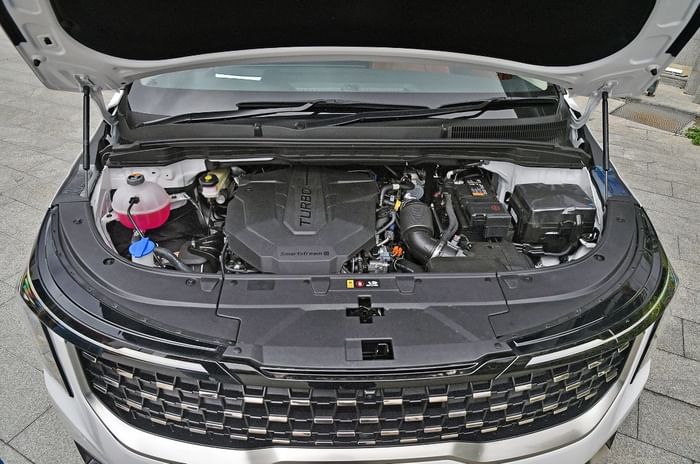
Power and torque are actually lower, at 193hp and 441Nm, and while Kia didn’t quote a figure, the kerb weight will no doubt have gone up. It doesn’t appear to have affected the driving character too much, though, and the Carnival’s powertrain remains unhurried but ample; Kia quotes a 0-100kph time of 10.7 seconds.
The 8-speed torque-converter automatic, too, isn’t the most eager, and that’s just as well in a big MPV, but its reluctance to kick down a gear quickly for an overtake can be annoying when you need it in a hurry. There’s a sport mode and paddle shifters, too, but you’ll seldom find yourself using them.
While the obvious benefit of the aluminium diesel engine is weight reduction, the unfortunate side effect is greater engine noise. And though not loud and clattery like that of an Innova Crysta, it is something a premium vehicle at this price point should do without.
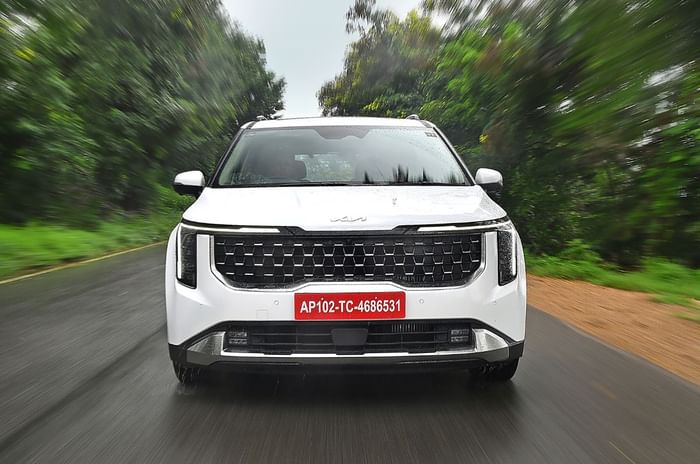
Kia has admirably stuck to its big diesel powerplant at a time when many are switching to petrol or hybrid, and apart from strong pulling power on the highway, its other advantage in a big car is fuel economy. The Kia Carnival’s fuel economy is rated at 14.85kpl by ARAI, but even in our day of hectic driving and shooting, we managed a respectable 10.9kpl.
Ride comfort is also important in a chauffeur-driven car like this, and the new Carnival largely delivers. It was a wise choice to stick to the same size of wheels and their chunky 235/60 R18 tyres, as they do provide a degree of cushioning to the ride. Overall, though, it offers a solid and stable ride at high speed, with some harshness over larger bumps.
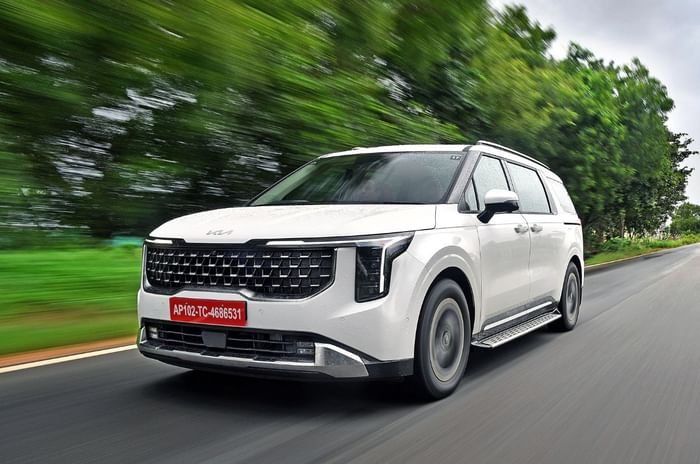
The new electric power steering (EPS) makes this big MPV very easy to manoeuvre at low speeds, and even when making lane changes on the highway, it gives a degree of confidence to the driver. That said, the previous hydraulic unit wasn’t noticeably heavy or cumbersome, particularly compared to that of an Innova Crysta.
2024 Kia Carnival price and verdict
With the generation-and-a-half leap that the Kia Carnival has taken, the advances over its predecessor are clear to see. It’s most evident in the features and tech, which now feel contemporary and right up there with the best. The updated look, which is modern and even a bit rugged, also adds to the appeal.
For all the updates, however, the basic proposition remains the same: that of a luxurious MPV that pampers the chauffeur-driven owner in the middle row with vast space and the ability to stretch out while also providing space for three more in the back and lots of luggage.
As such, then, its price of Rs 63.9 lakh (ex-showroom), a jump of Rs 20 lakh (it is locally assembled as before), feels excessive. The fact is that MPVs are gaining better acceptance as desirable luxury transport; Kia, as a brand, has grown in stature, and buyers are willing to spend more. And Kia has chosen to make the most of it. There’s a gap between Rs 30 lakh and Rs 1 crore (bookended by two very capable hybrid Toyotas), and while the old Carnival was positioned at the lower end of this space, it’s now moved up to the middle.
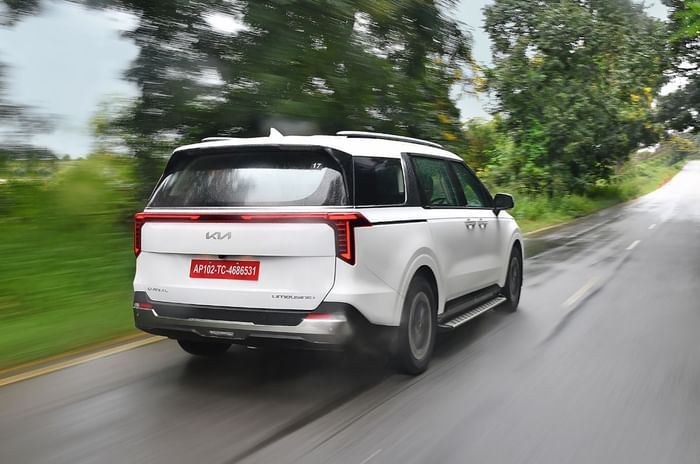
On paper, the updates might not seem to justify it, but the truth is people are willing to spend for the premium chauffeur-driven experience, as evidenced by the 3,000-plus bookings the new Carnival has received since launch, despite its price. And when it comes to delivering that experience, there’s no doubt the new Carnival has got the goods.
Also See:
Copyright (c) Autocar India. All rights reserved.


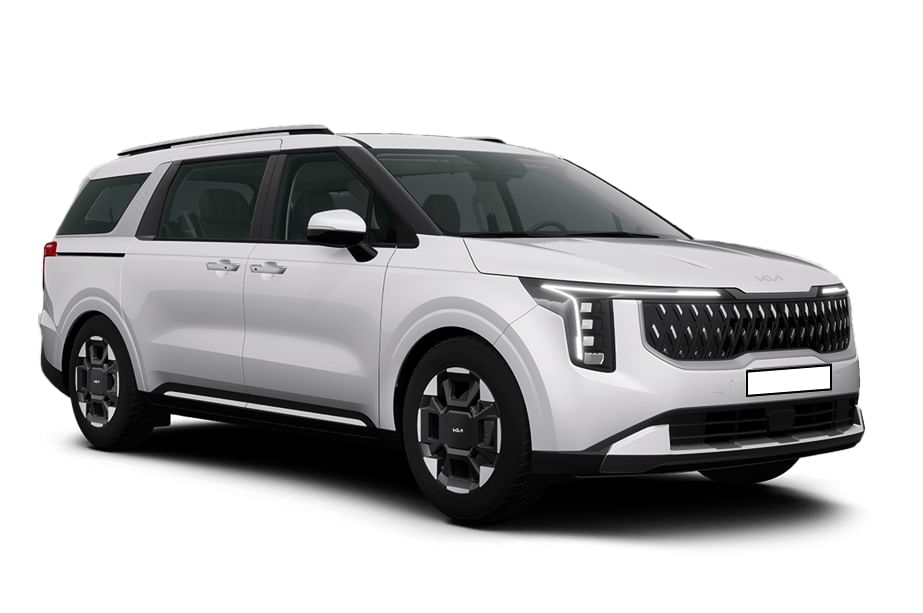

.jpg?w=234&h=156&q=90&c=1)

.jpg?w=234&h=156&q=90&c=1)

Comments
Member Login
Personal Details
No comments yet. Be the first to comment.